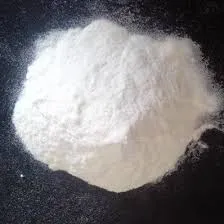
Dec . 01, 2024 00:49 Back to list
hpmc ingredient
Understanding HPMC An In-Depth Look at Hydroxypropyl Methylcellulose
Hydroxypropyl Methylcellulose (HPMC) is a non-ionic, water-soluble cellulose ether derived from natural cellulose. Its unique properties and versatility make it an essential ingredient in various industries, including pharmaceuticals, food, and construction. This article delves into the characteristics, applications, and benefits of HPMC, highlighting its importance in numerous formulations and products.
What is HPMC?
HPMC is synthesized through the modification of cellulose, obtained primarily from wood pulp or cotton. The process involves treating cellulose with propylene oxide and methyl chloride, resulting in a compound that combines hydrophilic and lipophilic properties. This modification enhances the solubility of cellulose in water, making HPMC a versatile ingredient.
HPMC is characterized by its ability to form gels, thick emulsions, and films when dissolved in water. It has various grades, which determine its viscosity, thermal gelation, and solubility properties. These properties make HPMC suitable for diverse applications across different industries.
Applications of HPMC
1. Pharmaceutical Industry
In the pharmaceutical sector, HPMC is extensively used as a binder, stabilizer, and controlled-release agent in tablet formulation. Its ability to form gels at different temperatures allows for sustained release of active pharmaceutical ingredients (APIs), improving therapeutic efficacy. Additionally, HPMC is utilized in the production of capsules and as a coating agent for drugs, enhancing solubility and bioavailability.
2. Food Industry
HPMC serves as a food additive with various functional benefits. It acts as a thickening agent, stabilizer, and emulsifier, helping maintain the desired texture and consistency in food products. Common applications include sauces, dressings, baked goods, and dairy products. HPMC is also utilized in gluten-free and low-calorie formulations, providing the desired mouthfeel and viscosity without significant caloric contribution.
3. Construction Industry
.hpmc ingredient

In construction, HPMC is a critical ingredient in plaster, mortar, and tile adhesives. It enhances water retention, workability, and adhesion properties of these materials, leading to improved performance and durability. HPMC contributes to the ease of application and allows for extended open time for adhesive products, making it a preferred choice among builders and contractors.
4. Cosmetic Industry
The cosmetic industry also benefits from HPMC, which is often incorporated into formulations for creams, lotions, and gels. Its thickening and stabilizing properties help achieve the desired texture and enhance the sensory experience of the products. Moreover, HPMC assists in creating customized formulations tailored for various skin types.
Benefits of HPMC
The use of HPMC across multiple industries can be attributed to several notable benefits
- Non-Toxic and Safe HPMC is considered safe for use in food and pharmaceutical applications, with no known toxicity, making it a preferred choice for industries concerned with health and safety.
- Versatile and Adaptable HPMC is available in various grades and formulations, allowing manufacturers to tailor products to meet specific needs and requirements.
- Improved Performance Whether in pharmaceuticals, food, or construction, HPMC enhances the performance and stability of formulations, contributing to product quality.
- Environmentally Friendly As a derivative of cellulose, HPMC is biodegradable and presents a lower environmental impact compared to synthetic polymers.
Conclusion
Hydroxypropyl Methylcellulose (HPMC) is a remarkable ingredient that plays an integral role in numerous industries. Its multifunctional properties, coupled with its safety and environmental benefits, make it a valuable component in the formulation of pharmaceuticals, food products, construction materials, and cosmetics. As research and development continue to explore innovative applications, HPMC is poised to remain a significant player in the world of ingredients, offering solutions that enhance product performance and meet the evolving needs of consumers and industries alike.
-
Versatile Hpmc Uses in Different Industries
NewsJun.19,2025
-
Redispersible Powder's Role in Enhancing Durability of Construction Products
NewsJun.19,2025
-
Hydroxyethyl Cellulose Applications Driving Green Industrial Processes
NewsJun.19,2025
-
Exploring Different Redispersible Polymer Powder
NewsJun.19,2025
-
Choosing the Right Mortar Bonding Agent
NewsJun.19,2025
-
Applications and Significance of China Hpmc in Modern Industries
NewsJun.19,2025







